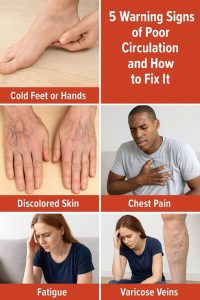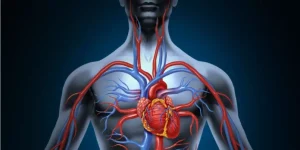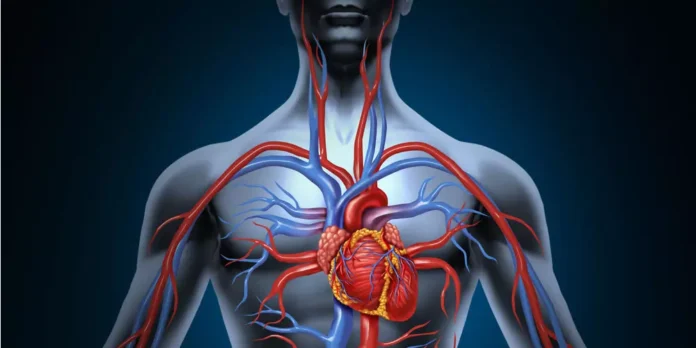As you get older, it’s crucial to have excellent circulation so that your body gets the right amount of oxygen and minerals. Blood circulation is crucial for all of the body’s systems because it supplies oxygen and nutrients to cells and removes waste. When circulation isn’t working right, the body can start to reveal small but vital signs that something is amiss. If you don’t take care of poor circulation, it could lead to more serious issues including nerve damage, varicose veins, blood clots, or even heart disease. Knowing the early indicators of bad blood flow and taking natural methods to help your vascular system can make you feel much better and enhance your health in the long run.
Having cold hands or feet all the time, even when it’s warm outdoors, is one of the most obvious signs of poor circulation. This happens a lot since your hands and feet are the parts of your body that are the farthest from your heart. Your hands and feet can feel a lot colder than the rest of your body if blood doesn’t get to them quickly. When blood arteries constrict or slow down, less warm blood travels to the fingers and toes. This is because blood doesn’t flow as quickly.
It might take longer for your hands and feet to warm up after being outside in the cool air, or they might feel cold to the touch. Try to move around more every day to naturally improve blood flow. You can keep your blood flowing by doing simple things like walking quickly, stretching, or using the stairs instead of the elevator. You might also try taking a shower with water that is both hot and cold. These substances can help your blood move more quickly. The food you eat is also essential. Cinnamon, cayenne pepper, and ginger are spices that make the body feel warm. They can also gently get the blood circulating from the inside.

Another indicator to look for is a lot of numbness, tingling, or “pins and needles” in the arms, legs, or feet. This feeling can be unsettling, especially if it happens when you aren’t putting any weight on the limb, such when you fall asleep on your arm by accident. This usually means that nerves aren’t getting enough blood to accomplish their duties. If the problem isn’t treated, it could hurt the nerves over time. Yoga, tai chi, and mild aerobics are all good for your nerves and circulation. Massaging the regions that hurt can also help blood flow and lessen pain. Drink adequate water because not drinking enough might make your blood thicker and make it harder for it to move. Don’t stay in the same place for too long. To keep your blood circulating, get up and move about every so often.
Another indicator that your circulation isn’t working right is swelling in your feet, ankles, or legs, especially after sitting or standing for a long time. This swelling is called edema. It commonly arises when blood pools in the lower limbs because of gravity and inadequate venous return. When blood flow is limited, fluid can leak into nearby tissues and make them swell. This is because your leg veins have to work harder to send blood back to the heart.
If this seems like something you’ve been through, consider putting your legs up as you relax to let gravity drain the blood that has piled up. Compression stockings can also help your veins work better and make swelling go down. Foods high in magnesium, like spinach, almonds, avocados, and pumpkin seeds, may help keep fluids in balance and blood flow better.

If you feel tired all the time or have low energy, it could be a sign that your circulation isn’t working right. If blood with a lot of oxygen doesn’t get to your muscles and brain quickly enough, you might feel weary all the time and have less energy. You might have a harder time finishing items that involve physical effort, or you might lose interest more quickly than usual. One of the easiest strategies to fight these symptoms is to move about to get your circulation flowing.
Taking a short walk during the day could help your blood flow and give you more energy. Food is also very important. Foods that are high in iron and help your blood carry more oxygen include lentils, chickpeas, red meat (in moderation), and dark leafy greens. Not smoking is also very important because nicotine makes blood vessels narrower and slows down blood flow. Processed foods that are heavy in sugar, trans fats, and sodium can also harm the thin lining of blood vessels over time.
Wounds that take a long time to heal, especially on the lower legs or feet, are another sign of poor circulation that people sometimes miss. If small cuts or sores don’t heal quickly or get infected, it could mean that the tissues aren’t getting enough oxygen and nutrients. People who have diabetes or vascular disease commonly get this, although even healthy people might develop it if their blood flow is bad.

You need to feed your body healthy fats to help it repair. Omega-3 fatty acids are found in fatty fish like salmon, chia seeds, flaxseeds, and walnuts. Omega-3s help protect blood arteries from getting stiff and lower inflammation. It’s also crucial to deal with stress because long-term stress can make blood vessels narrower and raise blood pressure, which makes blood flow worse. Meditation, simple breathing exercises, and regular walks in nature are all great strategies to reduce stress and improve blood flow.
You may be able to benefit your whole circulatory system by doing all of these things: moving every day, eating a diet high in nutrients, drinking enough water, and minimizing stress. Little things you do every day, like stretching every hour, eating more veggies, or swapping out sugary snacks for almonds or berries, might add up to a big difference over time. Many people find that natural remedies and modifications to their everyday life help, but it’s important to remember that if symptoms of poor circulation don’t go away or get worse, they should see a doctor. Blood clots, diabetes, and peripheral artery disease are all diseases that might cause similar symptoms and need to be addressed by a doctor.
Your blood flow is what keeps you alive in the end. Putting your circulation first means putting your health, vitality, and quality of life first. You can naturally improve your circulation by making small changes to your daily life. Your heart will be stronger, you’ll have more energy, and you’ll heal faster. Don’t wait for problems to show themselves before you act. Take control of your circulation now and help make the future healthier and more lively.
